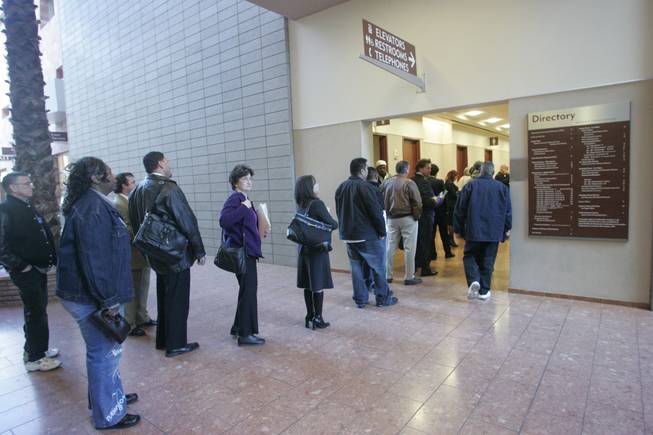
People queue up for the elevators at the Regional Justice Center on Tuesday. The elevators for the public are known to break down or make unplanned stops.
Wednesday, Feb. 6, 2008 | 2 a.m.
The unlikely mix of inmates and judges on the same elevator probably wasn’t what architects envisioned when they conceived what increasingly appears to be a flawed plan for the Regional Justice Center.
Yet through August, the accused and the adjudicators periodically had to share elevators. Officials worried violent inmates could use the slack from their shackles to strangle judges.
Since then, the policy has been that if one of the two elevators intended for the inmates breaks down — which happens more than the court and the detention center would like — the judges and their staffs temporarily relinquish one of their two remaining vertical transports to defendants. One of the inmates’ elevators broke down last week and was out of commission for half a day.
The solution has remedied concerns about the safety of judges, but it has created new inefficiencies, including the patrolling of the staff’s elevators. Corrections officers — not the court’s deputy marshals — transport inmates, but on days the defendants are moved in staff elevators, one marshal must be reassigned there.
Then there’s the issue of burdening elevators already in high demand. One of the two staff elevators is so fragile that when someone leans against its closed doors, it stops functioning, a court official noted.
It’s an occasional frustration for judges and their staffs, but one that’s all too familiar to lawyers, prospective jurors and court observers.
The 18-floor justice center also has just six elevators for attorneys and the public. They’re squeezed together in a dimly lighted wing off the first floor referred to by some frequent users as “the cave.”
Each morning — particularly on Mondays through Wednesdays — a line of exasperated lawyers and fidgety jurors-to-be spills from the wing out into the soaring foyer, awaiting the arrival of an elevator. Wait times sometimes reach 20 minutes.
Attorney Robert Draskovich, who makes 15 to 20 court appearances a day, estimates he spends 45 minutes each day awaiting and riding the elevators. Two of them are typically bumpy as they move up or down, and two others occasionally make unplanned stops or are immobile.
“Judges are frustrated with us for running late,” Draskovich said.
They’re more irritated by the building’s entire transport system, which some described as “illogical,” “disruptive” and “inefficient.”
It’s not uncommon for District Judge Douglas Herndon’s commute from the Summerlin area to be quicker than the time wasted within the justice center trying to reach his courtroom on the 16th floor, he said.
“There’s a lot of eating in for lunch. If you have a jury trial, you can’t leave and come back in an hour,” said District Judge Jennifer Togliatti, who pushed for the new policy to ensure that judges didn’t wind up stuck on elevators with inmates.
Some attorneys opt to bypass the elevators for the underused stairwell.
Herndon said he has had to tell lawyers, “ ‘Sit down, catch your breath.’ I don’t want that huffing and puffing.”
The questioning of prospective jurors often has to be scheduled to avoid peak times.
“I could not bring up 40 possible jurors at ... 9 a.m.,” Togliatti said. “I would be laughed out of the building.”
Clark County’s courthouse opened in October 2005, 3 1/2 years behind schedule and at least $15 million over budget. Maintenance problems immediately arose, as did the public’s awareness that the building had operational defects.
Early in the planning process, some county officials considered a building with more than six public elevators, but architectural plans proposed the six there now. That number corresponded to a needs analysis conducted at the previous courthouse.
The study now appears flawed: The former courthouse was horizontal, whereas the Regional Justice Center is decidedly vertical.
“My guess is that the survey drastically underestimated the peak use,” said Chuck Short, administrator of the courthouse.
County maintenance officials suspect the frequent breakdowns are attributable less to the building’s design — and the number of elevators — than to the normal wear and tear on heavily used transports.
“And holding elevators open too long too many times tends to shut them down,” said Michael Green, assistant director of the county’s real property management department.
Administrators and consultants have proposed a host of changes to ease users’ frustrations, including: cutting the time the elevator door is open; building an escalator to the basement floor; assigning elevators to specific floors; and adding staff directories on each floor.
Some of those corrections could be made by mid-March, Green said. The proposed escalator, which could cost between $250,000 and $500,000, could be built when the courthouse eventually expands, officials said.

Join the Discussion:
Check this out for a full explanation of our conversion to the LiveFyre commenting system and instructions on how to sign up for an account.
Full comments policy